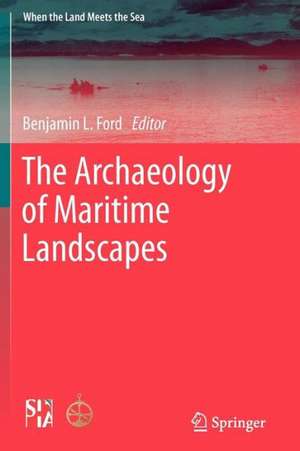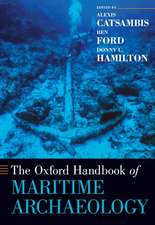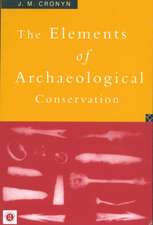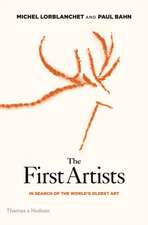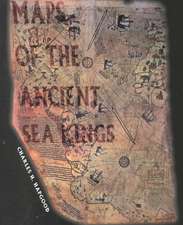The Archaeology of Maritime Landscapes: When the Land Meets the Sea, cartea 2
Editat de Ben Forden Limba Engleză Paperback – 13 dec 2012
However, what binds all of these sites together is the premise that each aspect of the landscape –cultural, political, environmental, technological, and physical – is interrelated and can not be understood without reference to the others. In this maritime cultural landscape approach, individual sites are treated as features within the larger landscape and the interpretation of single sites add to a larger analysis of a region or culture. This approach provides physical and theoretical links between terrestrial and underwater archaeology as well as prehistoric and historic archaeology; consequently, providing a framework for integrating such diverse topics as trade, resource procurement, habitation, industrial production, and warfare into a holistic study of the past.
Landscape studies foster broader perspectives and approaches, extending the study of maritime cultures beyond the shoreline. Despite this potential, the archaeological study of maritime landscapes is a relatively untried approach with many questions regarding the methods and perspectives needed to effectively analyze these landscapes.
The chapters in this volume, which include contributions from the United States, the United Kingdom, Norway, and Australia, address many of the theoretical and methodological questions surrounding maritime cultural landscapes. The authors comprise established scholars as well as archaeologists at the beginning of their careers, providing a healthy balance of experience and innovation. The chapters also demonstrate parity between method and theory, where thevarying interpretations of culture and space are given equal weight with the challenges of investigating both wet and dry sites across large areas.
| Toate formatele și edițiile | Preț | Express |
|---|---|---|
| Paperback (1) | 587.53 lei 6-8 săpt. | |
| Springer – 13 dec 2012 | 587.53 lei 6-8 săpt. | |
| Hardback (1) | 650.69 lei 6-8 săpt. | |
| Springer – 27 mai 2011 | 650.69 lei 6-8 săpt. |
Preț: 587.53 lei
Preț vechi: 691.20 lei
-15% Nou
Puncte Express: 881
Preț estimativ în valută:
112.43€ • 117.68$ • 93.57£
112.43€ • 117.68$ • 93.57£
Carte tipărită la comandă
Livrare economică 31 martie-14 aprilie
Preluare comenzi: 021 569.72.76
Specificații
ISBN-13: 9781461428886
ISBN-10: 1461428882
Pagini: 368
Ilustrații: XV, 352 p. 80 illus.
Dimensiuni: 155 x 235 x 19 mm
Greutate: 0.52 kg
Ediția:2011
Editura: Springer
Colecția Springer
Seria When the Land Meets the Sea
Locul publicării:New York, NY, United States
ISBN-10: 1461428882
Pagini: 368
Ilustrații: XV, 352 p. 80 illus.
Dimensiuni: 155 x 235 x 19 mm
Greutate: 0.52 kg
Ediția:2011
Editura: Springer
Colecția Springer
Seria When the Land Meets the Sea
Locul publicării:New York, NY, United States
Public țintă
GraduateCuprins
Preface: Putting the Wheels on Maritime Cultural Landscape Studies, David J. Stewart.- Introduction, Ben Ford.- Chapter I: Searching for Santarosae: Surveying Submerged Landscapes for Evidence of Paleocoastal Habitation off California’s Northern Channel Islands, Jack Watts, Brian Fulfrost, and Jon Erlandson.- Chapter 2: Testing the Paleo-Maritime Hypothesis for Glacial Lake Iroquois.- Implications for Changing Views of Past Culture and Technology, Margaret Schulz, Susan Winchell-Sweeney, and Laurie Rush.- Chapter 3: Lake Ontario Paleoshorelines and Submerged Prehistoric Site Potential in the Great Lakes, Jessi Halligan.- Chapter 4: The Shoreline as a Bridge, Not a Boundary: Cognitive Maritime Landscapes of Lake Ontario, Ben Ford.- Chapter 5: Rock, Paper, Shipwreck: The Maritime Cultural Landscape of Thunder Bay, Wayne R. Lusardi.- Chapter 6: Ship to Shore: Inuit, Early Europeans, and Maritime Landscapes in the Northern Gulf of St. Lawrence, William W. Fitzhugh, Anja Herzog, Sophia Perdikaris, and Brenna McLeod.- Chapter 7: Temporal Changes in a Pre-Contact and Contact Period Cultural Landscape along the Southern Rhode Island Coast, Christopher Jazwa.- Chapter 8: A Maritime Landscape of Old Navy Cove and Deadman’s Island, Krista Dana Jordan-Greene.- Chapter 9: Potential Contributions of a Maritime Cultural Landscape Approach to Submerged Prehistoric Resources, Northwestern Gulf of Mexico, Amanda M. Evans and Matthew E. Keith .- Chapter 10: Modeling Maritime Culture; Galveston, Texas in the Historic Period, Matthew E. Keith and Amanda M. Evans.- Chapter 11: The Hidden World of the Maritime Maya: Lost Landscapes along the North Coast of Quintana Roo, Mexico; Jeffrey B. Glover, Dominique Rissolo, and Jennifer P. Mathews.- Chapter 12: Material Culture and Maritime Identity: Identifying Maritime Subcultures through Artifacts, Heather E. Hatch.- Chapter 13: The “Richest River in the World”: The MaritimeCultural Landscape of the Mouth of the Río Chagres, Republica de Panamá, James P. Delgado, Frederick H. Hanselmann, and Dominique Rissolo.- .- Chapter 14: US Shipbuilding Activities at American River, South Australia: Finding Significance of ‘Place’ in the Maritime Cultural Landscape, Claire P. Dappert.- Chapter 15: “What Do You Want to Catch?”: Exploring the Maritime Cultural Landscapes of the Queenscliff Fishing Community, Brad Duncan.- Chapter 16: The Binary Relationship of Sea and Land, Christer Westerdahl.- Chapter 17: Places of Special Meaning: Westerdahl’s Comet, ‘Agency’, and the Concept of the ‘Maritime Cultural Landscape’, Joe Flatman.- Conclusion: The Maritime Cultural Landscape Revisited, Christer Westerdahl.
Notă biografică
Dr. Ben Ford is an Assistant Professor of Anthropology at Indiana University of Pennsylvania. His research interests include historical and maritime archaeology, and historic preservation, as well as the uses and perceptions of space and environment during the past.
Textul de pe ultima copertă
Maritime cultural landscapes are collections of submerged archaeological sites, or combinations of terrestrial and submerged sites that reflect the relationship between humans and the water. These landscapes can range in size from a single beach to an entire coastline and can include areas of terrestrial sites now inundated as well as underwater sites that are now desiccated.
However, what binds all of these sites together is the premise that each aspect of the landscape –cultural, political, environmental, technological, and physical – is interrelated and can not be understood without reference to the others. In this maritime cultural landscape approach, individual sites are treated as features within the larger landscape and the interpretation of single sites add to a larger analysis of a region or culture. This approach provides physical and theoretical links between terrestrial and underwater archaeology as well as prehistoric and historic archaeology; consequently, providing a framework for integrating such diverse topics as trade, resource procurement, habitation, industrial production, and warfare into a holistic study of the past.
Landscape studies foster broader perspectives and approaches, extending the study of maritime cultures beyond the shoreline. Despite this potential, the archaeological study of maritime landscapes is a relatively untried approach with many questions regarding the methods and perspectives needed to effectively analyze these landscapes.
The chapters in this volume, which include contributions from the United States, the United Kingdom, Norway, and Australia, address many of the theoretical and methodological questions surrounding maritime cultural landscapes. The authors comprise established scholars as well as archaeologists at the beginning of their careers, providing a healthy balance of experience and innovation. The chapters also demonstrate parity between method and theory, where thevarying interpretations of culture and space are given equal weight with the challenges of investigating both wet and dry sites across large areas.
However, what binds all of these sites together is the premise that each aspect of the landscape –cultural, political, environmental, technological, and physical – is interrelated and can not be understood without reference to the others. In this maritime cultural landscape approach, individual sites are treated as features within the larger landscape and the interpretation of single sites add to a larger analysis of a region or culture. This approach provides physical and theoretical links between terrestrial and underwater archaeology as well as prehistoric and historic archaeology; consequently, providing a framework for integrating such diverse topics as trade, resource procurement, habitation, industrial production, and warfare into a holistic study of the past.
Landscape studies foster broader perspectives and approaches, extending the study of maritime cultures beyond the shoreline. Despite this potential, the archaeological study of maritime landscapes is a relatively untried approach with many questions regarding the methods and perspectives needed to effectively analyze these landscapes.
The chapters in this volume, which include contributions from the United States, the United Kingdom, Norway, and Australia, address many of the theoretical and methodological questions surrounding maritime cultural landscapes. The authors comprise established scholars as well as archaeologists at the beginning of their careers, providing a healthy balance of experience and innovation. The chapters also demonstrate parity between method and theory, where thevarying interpretations of culture and space are given equal weight with the challenges of investigating both wet and dry sites across large areas.
Caracteristici
Extensive geographic scope, covering maritime sites in the United States, Europe, and Australia Comprehensively explores this theoretical and methodological framework applied to concrete case studies Landscape approach provides cohesive theory of terrestrial and underwater site interaction Includes supplementary material: sn.pub/extras
